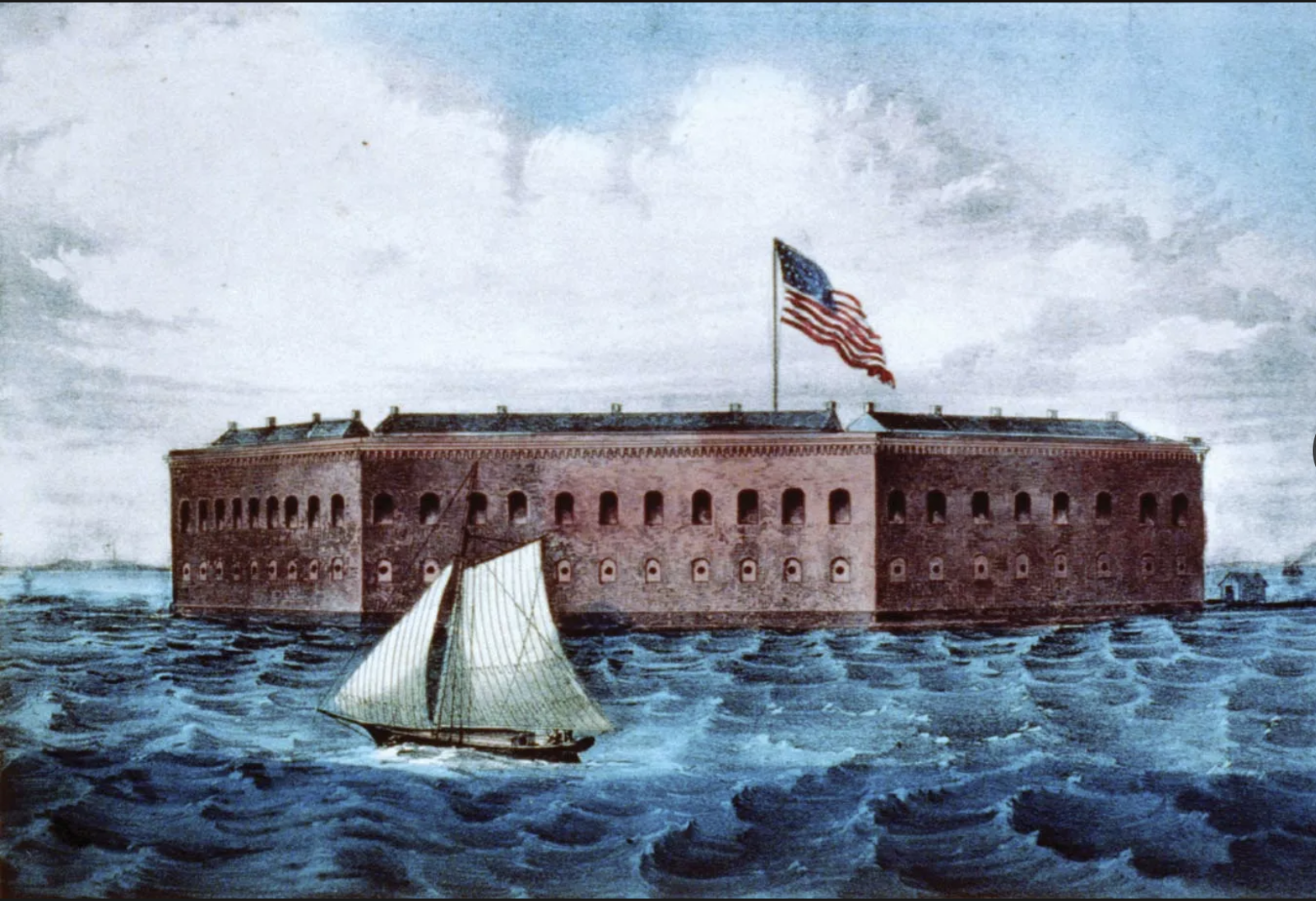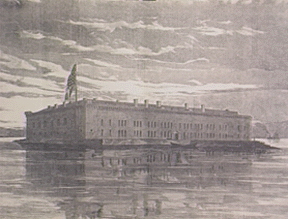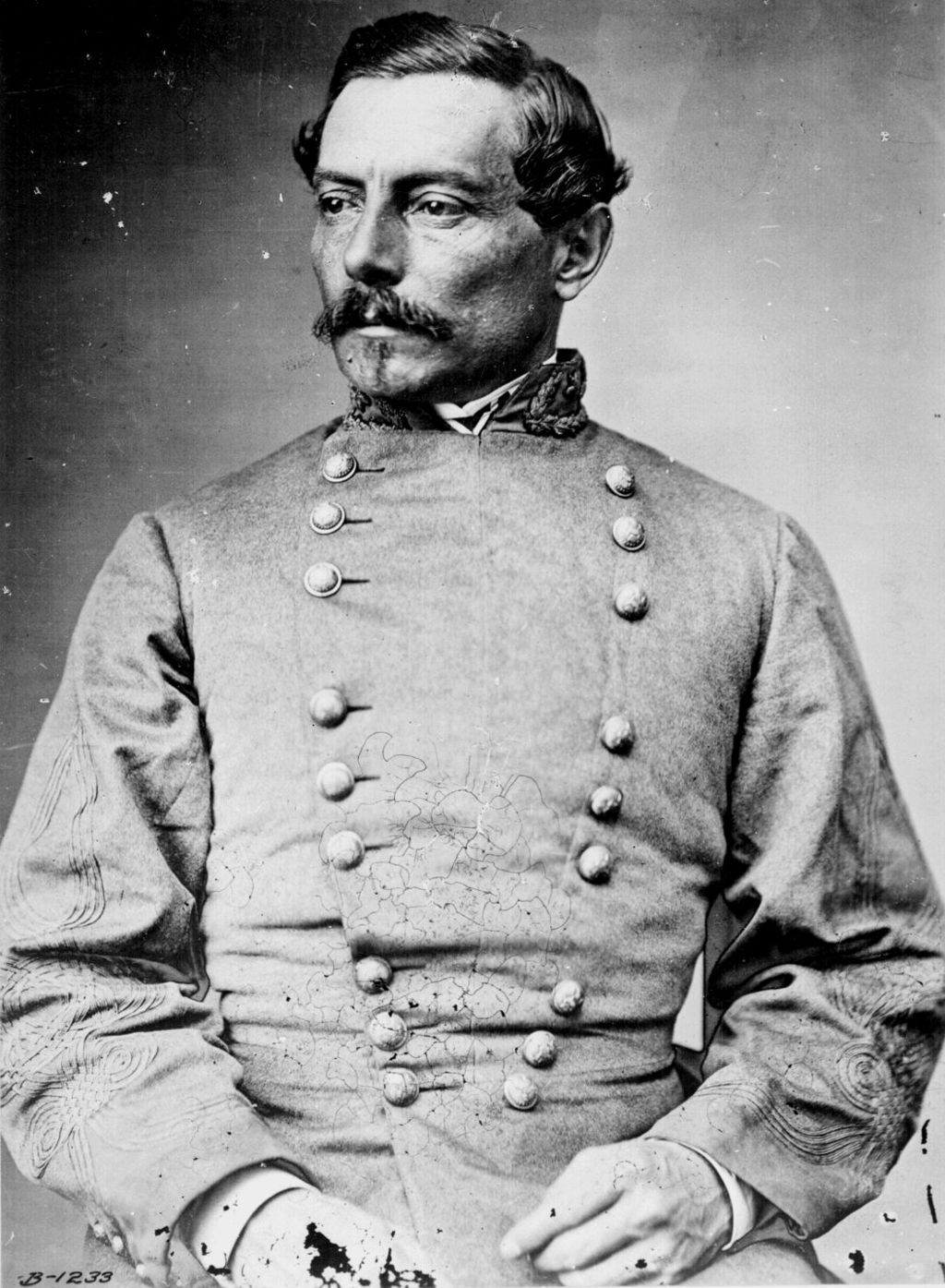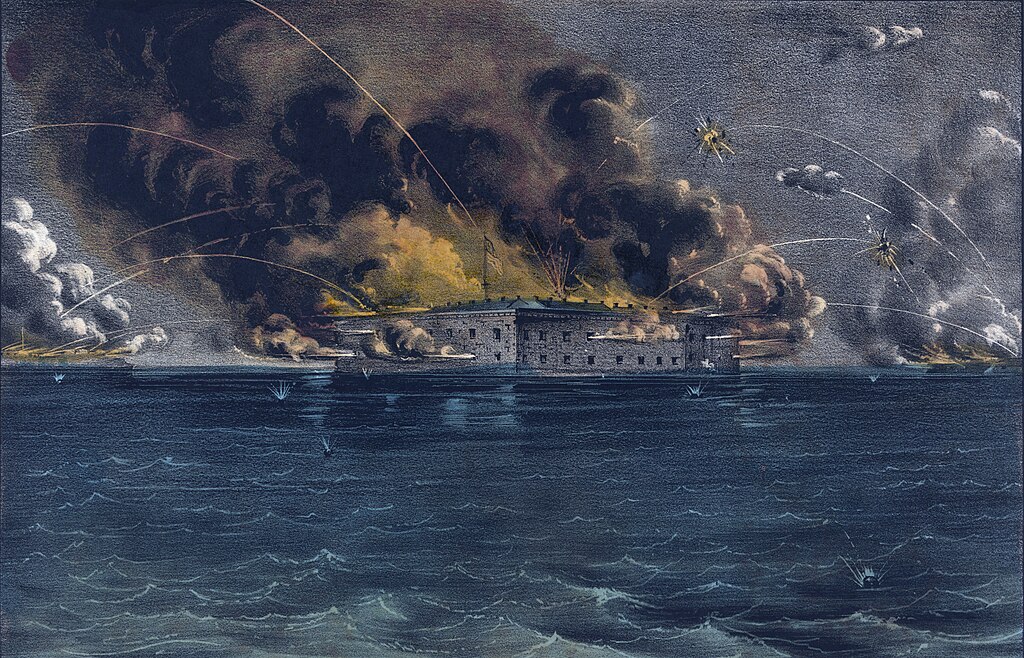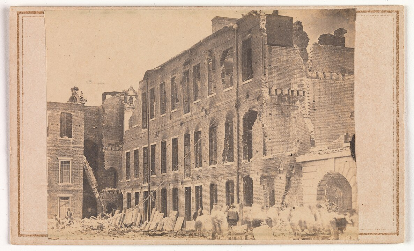TWO WEEKS LEADING UP TO THE FIRING ON FORT SUMTER
As March slipped into April 1861, America stood at a crossroads. About the only thing the North and South agreed on was that neither wanted to start the American Civil War.
If President Abraham Lincoln surrendered Fort Sumter, as South Carolina demanded, he would be acknowledging the end of the Union which he said he would never do in his inaugural address.
Yet according to historian Robert Rosen, author of A Brief History of Charleston, if Confederate President Jefferson Davis and S.C. Gov. Francis Pickens allowed Federal troops to remain at Fort Sumter, the Confederate government would appear so weak it had to allow an enemy force to maintain a military presence in one of its most important ports. Plus, if the South initiated the war, thousands of Northerners who were noncommittal about secession would rally to Lincoln’s support.
The 85 or so Federal soldiers at Fort Sumter, under command of U.S. Maj. Robert Anderson, were in an indefensible position against 6,000 Confederate troops who surrounded them. They knew Anderson couldn’t hold out much longer, as he was running out of food and supplies.
Against the advice of his Cabinet, Lincoln decided to resupply the men holding Fort Sumter. But what did he mean by "resupply"?
If the Confederates fired on ships sailing under the U.S. flag, Lincoln reasoned, the North would be justified in defending themselves, and the South would be held responsible for initiating the war.
Here’s how the two weeks prior to the firing on Fort Sumter unfolded.
April 1
After meeting with Secretary of State William Seward, Army Capt. Montgomery Meigs, and Navy Lt. David Porter, Lincoln ordered the commandant of the Brooklyn Navy Yard, Capt. Andrew Foote, to prepare the warship Powhatan, the largest in the U.S. Naval fleet, for an undisclosed mission and replace its captain, Samuel Mercer, with Lt. David Porter. The order said under no circumstances was the U.S. Navy Department to be informed of these instructions.
Meanwhile, Mercer had received orders from Navy Secretary Gideon Welles for the Powhatan to resupply the garrison at Fort Pickens in Florida. Was this an honest lack of communications between federal departments or a strategic decision by Lincoln to provoke the Confederacy into war? We'll never know for sure.
April 2
It was a rainy, windy Tuesday, and the captain of the merchant schooner Rhoda H. Shannon, which had departed from Boston to deliver a shipment of ice to Savannah, requested a weather update. The report would prove to be unreliable.
April 3
As the weather got worse, the Shannon became disoriented. Around 3 p.m. its captain mistook Charleston Harbor as the entrance to Tybee Island at the mouth of the Savannah River, which he blamed on faulty navigational equipment and a heavy gale.
He raised the U.S. flag per protocol for a ship requesting a local pilot to come aboard to bring the schooner in safely. When no one responded, he decided to pilot the ship into the harbor himself.
Lt. Col. W.G. DeSaussure, commander of Confederate batteries on Morris Island, had orders from Gen. P.G.T. Beauregard to prevent any ship flying the U.S. flag from entering the harbor. As the Shannon passed by, DeSaussure’s troops fired three warning shots across its bow. The Shannon dropped anchor.
DeSaussure sent a skiff to assess damage to the schooner and its crew. Watching the situation unfold from his position at Fort Sumter, an alarmed Anderson did the same.
The captain explained his mistake to both parties, who expressed relief that no one had been injured nor the schooner seriously damaged. DeSaussure said the Shannon could remain at anchor until the storm passed. The scouts returned to their bases. Once the weather cleared, the Shannon quietly left.
April 4
Lincoln met with naval Capt. Gustavus V. Fox to discuss “the Sumter situation.” Though details of the secret meeting are unknown, Lincoln afterward announced he would send a naval expedition to resupply Fort Sumter, notifying Gov. Pickens of its arrival.
Cabinet members cautioned against notifying the governor, but Lincoln was adamant -- as doing so was key to his secretive plan.
April 5
Secretary of State Seward and Secretary of the Navy Welles realized each had planned different missions spearheaded by the warship Pohowtan using different captains possibly going to different destinations.
Shortly before midnight, the two took their unsettled argument directly to Lincoln, who was working late, as he often did. Initially, Lincoln sided with Seward’s mission to send the Powhatten to Florida, yet after Welles produced copies of his orders, Lincoln agreed the Powhatan should go to Fort Sumter. Welles did not telegram New York shipyard’s Capt. Foote with confirmation until the next morning.
April 6
Capt. Foote was torn between his two superiors. He chose to prioritize the orders he had received directly from President Lincoln, dispatching a large naval expedition including several merchant ships, warships carrying 300 to 500 men and arms, and tugboats to land reinforcements at Fort Sumter (sources differ on exact numbers). Welles’ telegram did not reach Foote until after the first ships of the expedition left, heading south.
Lincoln sent a message to Anderson in his own handwriting, saying to “... expect an attempt will be made to supply Fort Sumter with provisions only; and that, if such an attempt be not resisted, no effort to throw in men, arms, or ammunition will be made without further notice.” A copy of the message went to S.C. Gov. Pickens.
Rosen calls the note’s wording “a masterpiece of ambiguity.” To Northern readers the message implied the government was on a humanitarian mission taking food and medicine to hungry men. To President Davis and Gov. Pickens, however, the message not only said provisions would be sent to Fort Sumter, which Pickens had publiclly forbade, it also indicated force would be used if they did not allow it. Surely that was why warships were included in the expedition.
Or was it?
No one, not even Secretary Seward, knew Lincoln had secretly given orders to have the warships closely pass by Charleston en route to Fort Picken in Florida.
Davis and Pickens now had two options: either capture Fort Sumter before the naval expedition arrived or, they assumed, allow armed warships to enter Charleston Harbor.
April 7
S.C. Gov. Francis Pickens’ awoke to what would be a most disconcerting 54th birthday for himself. He received Lincoln’s message saying as long as local authorities did not try to stop the federal government's resupply effort, the expedition would not land reinforcements. If, however, Pickens interfered with their mission, Federal troops would take action to defend their ships.
And what about Lincoln’s assurance that “no effort to throw in men, arms, or ammunition will be made without further notice?” Might he move his warships into position within Charleston Harbor, then suddenly “give further notice?”
Pickens could not allow Federal troops to maintain a presence in Charleston Harbor. Yet neither did he want his legacy to be as the one responsible for starting the American Civil War.
Historians still debate the meaning of Lincoln’s message. Some caution that we should not try to “read between the lines” when interpreting history. Others say Lincoln’s message was clearly provocative, forcing the Confederacy into a position where they had no option but to stop the federal naval expedition with an attack.
Meanwhile, the first tugboat to land supplies – and possibly soldiers – left New York.
April 8
The armed revenue cutter Harriet Lane left New York heading south, as did a second tugboat.
That evening, Pickens and Beauregard notified Confederate President Davis of Lincoln’s message. Davis immediately instructed Beauregard that under no circumstances was he to allow any provisions to reach Fort Sumter.
April 9
The Pawnee, the U.S. Navy’s heaviest sloop of war, left Washington heading south.
The Confederate Cabinet, meeting in Montgomery, decided to capture Fort Sumter before the expedition arrived.
April 10
The Pocahontas, with 95 men and six cannons, departed Norfolk, heading south.
Confederate Secretary of State Robert Augustus Toombs wired Beauregard with orders to demand Anderson’s surrender, or else once he felt certain the fort was about to be resupplied, to open fire. Beauregard replied that he would demand the surrender the next day at noon.
April 11
Shortly before noon, three of Beauregard’s aides rowed to Fort Sumter with his demand to evacuate.
Diarist Emma Holmes, who from her family's mansion at 19 East Battery had a front-row seat to the action taking place in the harbor, wrote: “A day never to be forgotten in the annals of Charleston … the whole afternoon & night, the Battery was thronged with spectators of every age and sex, anxiously awaiting with the momentary expectation of hearing the war of cannon opening on the fort or on the fleet which was reported outside the bar. Everybody was restless and all who could go were out.”
After consulting with his officers, around 4 p.m. Anderson replied to Beauregard, who once had been a student of his at West Point: “I have the honor to acknowledge the receipt of your communication demanding the evacuation of this fort, and to say, in reply thereto, that it is a demand with which I regret that my sense of honor, and of my obligations to my Government, prevent my compliance.”
Shortly before midnight, the Harriet Lane anchored off Charleston Harbor.
April 12
Soon after the Harriet Lane’s arrival, the supply ship Baltic and warship Pawnee joined it off Charleston Harbor’s bar.
The Confederate delegation left Fort Sumter in the early morning hours to notify Beauregard that Anderson had rejected the ultimatum. With the Federal naval expedition now outside the harbor, time was up for Beauregard.
Around 3 a.m., he sent Col. James Chesnut back to Sumter with his final message: “I am ordered by the Government of the Confederate States to demand the evacuation of Fort Sumter. My aides, Colonel Chesnut and Captain Lee, are authorized to make such demand of you. All proper facilities will be afforded for the removal of yourself and your command, together with company arms and property, to any post in the United States which you may select. The flag which you have upheld so long and with so much fortitude, under the most trying circumstances, may be saluted by you taking it down. Colonel Chesnut and Captain Lee will for a reasonable time await your answer. I am, sir, very respectfully, your obedient servant.”
Anderson reaffirmed he would follow his orders not to surrender the fort, closing his message with “Thanking you for the fair, manly and courteous terms proposed and for the high compliment paid me.”
As Beauregard had empowered him, Chesnut responded: “SIR: By authority of Brigadier-General Beauregard, commanding the provisional forces of the Confederate States, we have the honor to notify you that he will open the fire of his batteries on Fort Sumter in one hour from this time.”
At 4:30 a.m. a ceremonial signal shot from Fort Johnson exploded far above Sumter. Ten minutes later, the Morris Island batteries opened fire.
Rather than assist Anderson with defending the fort, as one would expect, the Federal ships waiting outside the harbor turned and left the troops within Fort Sumter to whatever fate awaited them.
The battle lasted 34 hours before Anderson surrendered. Despite the attack’s intensity, no one on either side was killed, nor even seriously wounded. True to his word, Beauregard allowed Anderson to strike the Federal colors ceremoniously. The Union soldiers then boarded a ship to New York, where they were welcomed as heroes.
The Civil War had begun.
